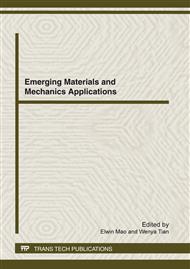[1]
A. Chu, D. S. Mavinic, H. G. Kelly, et al., Volatile fatty-acid production in thermophilic aerobic digestion of sludge, Water Research. 28(1994)1513-1522.
DOI: 10.1016/0043-1354(94)90217-8
Google Scholar
[2]
S. Danesh and J. A. Oleszkiewicz, Volatile fatty acid production and uptake in biological nutrient removal systems with process separation, Water Environment Research. 69(1997)1106-1111.
DOI: 10.2175/106143097x125830
Google Scholar
[3]
J. A. Oleszkiewicz and J. L. Barnard, Nutrient removal technology in north america and the european union: A review, Water Quality Research Journal of Canada. 41(2006)449-462.
DOI: 10.2166/wqrj.2006.048
Google Scholar
[4]
Z. X. Quan, Y. S. Jin, C. R. Yin, et al., Hydrolyzed molasses as an external carbon source in biological nitrogen removal, Bioresource Technology. 96(2005)1690-1695.
DOI: 10.1016/j.biortech.2004.12.033
Google Scholar
[5]
M. Thomas, P. Wright, L. Blackall, et al., Optimisation of noosa bnr plant to improve performance and reduce operating costs, Water Science and Technology. 47(2003)141-148.
DOI: 10.2166/wst.2003.0639
Google Scholar
[6]
Q. Yuan, R. Sparling and J. A. Oleszkiewicz, Waste activated sludge fermentation: Effect of solids retention time and biomass concentration, Water Research. 43(2009)5180-5186.
DOI: 10.1016/j.watres.2009.08.019
Google Scholar
[7]
P. Kampas, S. A. Parsons, P. Pearce, et al., Mechanical sludge disintegration for the production of carbon source for biological nutrient removal, Water Research. 41(2007)1734-1742.
DOI: 10.1016/j.watres.2006.12.044
Google Scholar
[8]
X. L. Liu, H. Liu, G. C. Du, et al., Improved bioconversion of volatile fatty acids from waste activated sludge by pretreatment, Water Environment Research. 81(2009)13-20.
DOI: 10.2175/106143008x304640
Google Scholar
[9]
P. M. Biradar, S. B. Roy, S. F. D'Souza, et al., Excess cell mass as an internal carbon source for biological denitrification, Bioresource Technology. 101(2010)1787-1791.
DOI: 10.1016/j.biortech.2009.10.049
Google Scholar
[10]
T. -H. Kim, Y. -K. Nam, C. Park, et al., Carbon source recovery from waste activated sludge by alkaline hydrolysis and gamma-ray irradiation for biological denitrification, Bioresource Technology. 100(2009)5694-5699.
DOI: 10.1016/j.biortech.2009.06.049
Google Scholar
[11]
J. Tong and Y. G. Chen, Recovery of nitrogen and phosphorus from alkaline fermentation liquid of waste activated sludge and application of the fermentation liquid to promote biological municipal wastewater treatment, Water Research. 43(2009).
DOI: 10.1016/j.watres.2009.04.015
Google Scholar
[12]
X. Li, H. Chen, L. Hu, et al., Pilot-scale waste activated sludge alkaline fermentation, fermentation liquid separation, and application of fermentation liquid to improve biological nutrient removal, Environmental Science & Technology. 45(2011).
DOI: 10.1021/es1031882
Google Scholar
[13]
G. H. Yu, P. J. He, L. M. Shao, et al., Toward understanding the mechanism of improving the production of volatile fatty acids from activated sludge at ph 10. 0, Water Research. 42(2008)4637-4644.
DOI: 10.1016/j.watres.2008.08.018
Google Scholar
[14]
APHA, Standards methods for the examination of water and wastewater, 20th edition, American Public Health Association, Washington, DC, (1998).
Google Scholar
[15]
C. P. L. Grady Jr, G. T. DAIGGER and H. C. Lim, Wastewater treatment: Second edition, revised and expanded, Marcel Dekker, Inc, New York, (1999).
Google Scholar


